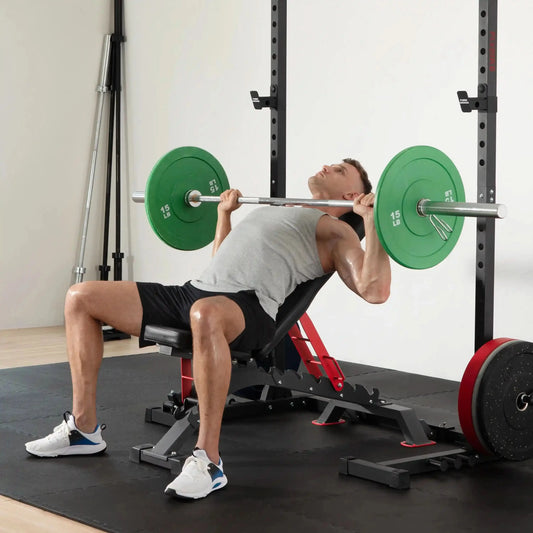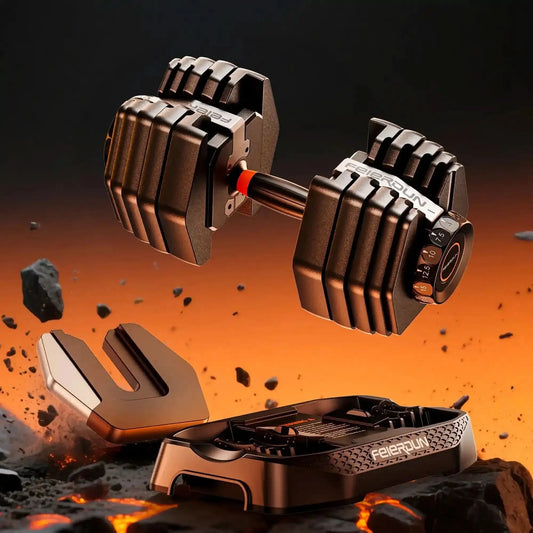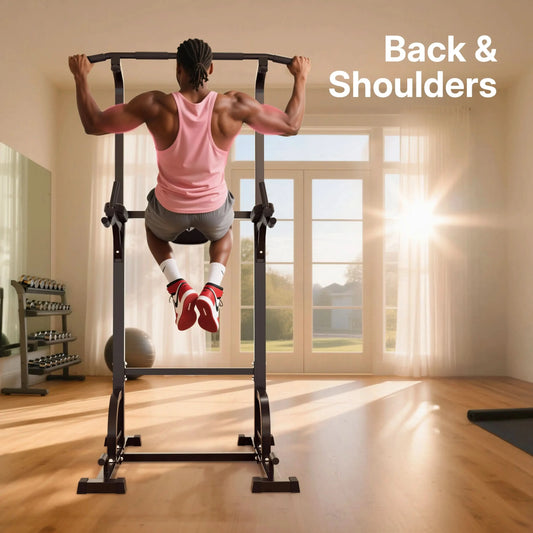Adjustable weight benches, once found only in gyms, are now increasingly common in homes, with fitness enthusiasts using them to help them reach their goals. However, choosing the right adjustable bench is crucial before purchasing one. What are the advantages and disadvantages of the more common pin-style and ladder-type weight benches? Today, we'll discuss different adjustable settings; the right one can significantly boost your workouts.
Why Weight Bench Adjustment Mechanisms Matter?
Adjustable
benches are the backbone of any strength-training setup. The ability to modify back-pad angles allows you to target different muscles, perform compound lifts, and maintain correct form.
The global weight-training bench market was valued at around USD 726 million in 2024. It is forecasted to reach USD 1.29 billion by 2033, growing at a 6.6 % CAGR (IMARC Group, 2024).
This growth is largely driven by demand for adjustable and multi-functional equipment as home-gym adoption accelerates.
Yet most buyers overlook one crucial engineering detail: the adjustment mechanism. Two main designs dominate the market:
- Ladder-style benches, using interlocking teeth or notches.
- Pin-style benches, using a sliding tube with pop-pins or pull-pins.
The difference affects stability, adjustment speed, and longevity. Understanding how each system works ensures you invest in the right bench for your goals.
Understanding Adjustable Benches
What Is an Adjustable Bench?
An adjustable weight bench allows the backrest (and sometimes seat pad) to lock into multiple positions: flat, incline, or decline. It enables a broader range of exercises such as presses, rows, curls, and crunches.
According to Growth Market Reports (2024), adjustable variants make up over 55 % of total bench sales.
Typical components include:
-
Frame: usually heavy-gauge steel tubing.
-
Back and seat pads: high-density foam for support.
-
Adjustment mechanism: ladder or pin system that dictates angle and load capacity.
These mechanisms directly impact safety, training efficiency, and equipment durability.
What is the Function of the Weight Bench Adjustment Mechanism?
The adjustment system determines more than comfort:
-
Training range: angle variability affects which fibers of the pectoralis major and anterior deltoid are activated.
-
Ease of transition: fast angle changes improve workout flow, critical in supersets and circuit training.
-
Safety: a secure lock prevents slippage under load
-
Maintenance: simpler systems generally last longer and require fewer replacements.
As Men’s Health Fitness Lab experts emphasize, “Adjustment reliability is the first thing to check in any bench review. A wobbly bench means compromised strength output.”
What Is a Ladder-Style Bench?
A ladder-style adjustable bench employs a notched steel track resembling a staircase. The support arm of the backrest hooks into these grooves to lock the desired angle. When you lift the pad and re-seat it into another notch, you shift between positions, typically from flat (0°) to upright (85–90°).
Advantages
-
Rapid angle changes: lifters can adjust within seconds, ideal for superset transitions.
-
High stability: direct mechanical contact minimizes wobble, making it reliable under loads exceeding 1,000 lb in premium models.
-
Low maintenance: Few moving parts reduce long-term wear.
-
Durability: solid steel contact points outperform pins for longevity in commercial use.
Disadvantages
-
Limited angle increments: fewer adjustment points (often 6–8) restrict fine-tuning.
-
Heavier and bulkier: stronger frames add weight, limiting portability.
-
Audible adjustment: the “clank” when reseating the bar is louder than pin clicks.
Still, for lifters prioritizing stability and speed, ladder benches remain the industry benchmark for heavy pressing and powerlifting routines. You can check out our ladder-style bench for more details
What Is a Pin-Style Bench?
A pin-style (often called “pop-pin”) adjustable bench uses a metal spine or curved rail with multiple holes. A spring-loaded pin or pop-pin is pulled out, the back (and/or seat) pad is moved to the desired angle, the pin is released, and it locks into one of the holes. These systems resemble the indexing mechanisms seen in selectorized gym machines.
Advantages
- Allows fine-angle increments, enabling more precise positioning of the back pad for incline, upright, or decline uses.
- Often quieter and lower profile, making them suitable for home gyms where noise and bulk matter.
- Typically lighter and more compact than heavy-duty ladder-system benches (depending on model).
Disadvantages
- Because the system relies on a pin locking into a hole, over time, the pin or hole may wear, loosen, or become misaligned.
- Adjustment may take slightly more time or require two hands (pull pin + adjust pad) compared to certain ladder styles.
- Some budget models may use thinner gauge steel, which can result in less stability under heavy load.
Ladder vs Pin: Feature-by-Feature Comparison
Stability and Safety
Ladder-style benches engage multiple steel notches directly under load, offering very low play and higher perceived rigidity. Independent
Garage Gym reviews of models with ladder systems noted less than 1 mm wobble under heavy use.
Pin-style benches are generally safe and effective but depend more on proper seating of the in and integrity of the frame-spine holes. Mis-seating can increase the risk of slippage.
Adjustment Speed and Ease of Use
Ladder systems allow nearly instantaneous angle changes: lift pad, slide to notch, drop in. Pin systems require pulling the pin, moving the pad, and ensuring the pin locks, slightly more steps, though still reasonable.
Durability and Maintenance
Ladder systems have fewer moving parts and less dependency on small components like spring-loaded pins; thus, less frequent maintenance is required.
Pin systems may need occasional checking of the pin’s spring action and hole wear. Expert advice notes that ladder mechanisms are more durable on budget benches.
Weight Capacity
Because ladder-style benches often include heavier-gauge steel and improved support structures, they tend to support higher loads. Independent
Garage Gym reviews cite ladder benches as preferred in heavy-duty use (125 lb bench built from 11-/7-gauge steel in one case), using ladder adjustment.
Pin-style benches can support high loads as well, but at comparable price points, they may use lighter build materials.
Cost and Value
Pin-style benches often come at a lower cost due to slightly simpler framing and fewer large structural elements.
Ladder-style benches typically cost more but offer heavier-duty performance. Based on real reviews and user experience, if you value product durability, you should choose a ladder bench.
Aesthetic and User Experience
Ladder benches often look industrial, with visible notches and heavy steel.
Pin benches can have cleaner aesthetics, sleeker frames, and minimal exposed mechanism elements.
Real-World Use Cases
For Powerlifters and Strength Athletes
If your focus is maximal lifts, heavy compound pressing (bench press, incline press), and minimal compromise on stability, a ladder-style adjustable bench is often optimal.
The superior mechanical contact under load and quick adjustment between sets make it suited to high-intensity strength work.
For General Fitness or Home Gym Users
If your training involves varied exercises (dumbbell presses, flyes, seated work, multiple angle changes), a pin-style bench may offer better angle flexibility. It will also allow faster transitions between movements, while taking up less space and costing less.
For Personal Trainers and Gyms
In commercial gym settings where equipment is used by multiple users with varied body types and frequent adjustments, ladder-style benches reduce maintenance and adjustment issues.
In smaller studios or trainers’ home setups where aesthetics, space, and flexibility matter, pin-style benches may fit better.
Expert Insights and User Reviews
Many equipment-review sites and strength-training experts evaluate adjustable benches not just on angle options but on mechanism reliability, build quality, and long-term performance.
For instance, according to the editors at Men’s Health, after testing more than 30 benches:
“A great weight bench opens the door to a ton of exercise possibilities … the best weight benches are sturdy and reliable.”
Reviewers at Garage Gym Reviews noted ladder-style back adjustment and achieved 4.7/5 in their testing. They called out its “zero pad gap” and capacity for high loads (up to 1,000 lb) as key benefits.
From reddit user communities: “I prefer a ladder. The ladder is easier to adjust and generally safer, as you don’t need to be sure the pin is through the hole. There are lots of examples of guys missing the hole and it falling when they do their first rep.”
In summary, experts and users agree that the adjustment mechanism matters. Ladder-style tends to score higher on durability and speed. Pin-style tends to score higher on flexibility and home-gym suitability.
Ladder vs Pin Bench: Comparison Table (Quick Reference)
Which One Should You Choose?
Choose based on your primary training goals, budget, and space constraints.
-
Strength athlete/powerlifter: You bench 315 lb+ regularly. You want a bench that won’t wiggle under load and allows quick angle shift between flat and incline. Ladder-style gives you that.
-
Fitness enthusiast/home gym: You use your bench for presses, flyes, seat adjustments, and cable work. You change angles often, storage and noise matter. Pin-style offers the best fit.
-
Trainer/studio owner: Many users, varied lifts, need durability and fast turnaround. Ladder-style is preferred for low maintenance and wear-resistance.
-
Small apartment gym: Space is tight, and you move your bench often, you lift moderate weights. Pin-style gives the portability and flexibility you need.
Key Reminders (to avoid regrets)
- Don’t pick mechanism types in isolation. Evaluate build quality (frame steel gauge, pad design), weight capacity, angle range, pad gap, and height.
- Always ensure ratings are realistic: a 500 lb capacity bench may actually mean ~300 lb user + 200 lb load if safety margins are low.
- For home use, also consider storage (can it stand vertically?), mobility (wheels/handle), and noise when adjusting.
- Mechanism reliability matters. A poorly fitting pin or worn latch can compromise safety over time.
In short, there is no absolute “best” bench mechanism. The best mechanism is the one aligned with your training style, space, and budget.
Final Verdict: Ladder vs Pin-Style Weight Benches
Both ladder-style and pin-style benches deliver what adjustable benches were invented for: versatility. But they differ in engineering philosophy and user focus.
A ladder-style bench is built like a tank. Its mechanical teeth lock into place under pure steel-on-steel contact, minimizing play even under 1,000 lb+ loads. This makes it the professional choice for powerlifters, strength athletes, and commercial gyms. The trade-off is weight, noise, and cost.
A pin-style bench is built for flexibility. It favors smoother operation, quieter adjustments, and finer angle increments. These features are appreciated by home gym owners and general fitness users who train in smaller spaces.
The downside is, however, more moving parts, occasional pin wear, and slightly less structural rigidity under maximal load.
Industry consensus echoes this divide.
- JourneyMan HQ notes that premium ladder models consistently outperform pin systems for stability and longevity in commercial settings. (JourneyMan HQ)
- Garage Gym Lab testers highlight that pin-style benches excel in versatility for moderate-intensity home routines. (Garage Gym Lab)
Key Takeaways














